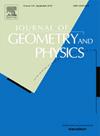梯度Schouten孤子的刚性结果
IF 1.2
3区 数学
Q1 MATHEMATICS
引用次数: 0
摘要
本文考虑了梯度Schouten孤子,它与n维伪欧几里得空间共形,在(n−1)维平移群作用下不变。我们给出了所有这样的解,并进一步证明了在黎曼情况下,不存在与欧几里德空间共形且对平移不变的完全梯度Schouten孤子。进一步,我们考虑M=(Bn,g)×(Fm,gF)型的ρ-爱因斯坦孤子,其中(Bn,g)与伪欧几里德空间共形,在伪正交群的作用下不变,(Fm,gF)是爱因斯坦流形。我们给出了梯度Schouten孤子情况的所有解,在黎曼情况下,我们证明了如果M=(Bn,g *)×(Fm,gF)是完全梯度Schouten孤子,那么(Bn,g *)与Sn−1×R是等距的,Fm是紧致爱因斯坦流形。本文章由计算机程序翻译,如有差异,请以英文原文为准。
Rigidity results on gradient Schouten solitons
In this paper, we consider gradient Schouten solitons, conformal to an n-dimensional pseudo-Euclidean space and invariant under the action of an -dimensional translation group. We provide all such solutions and further, we prove that, in the Riemannian case, there does not exist a complete gradient Schouten Soliton that is conformal to Euclidean space and invariant to translation. Furthermore, we consider ρ-Einstein solitons of type , where is conformal to a pseudo-Euclidean space and invariant under the action of the pseudo-orthogonal group, and is an Einstein manifold. We provide all the solutions for the gradient Schouten soliton case, in the Riemannian case, we prove that if is a complete gradient Schouten soliton, then is isometric to and is a compact Einstein manifold.
求助全文
通过发布文献求助,成功后即可免费获取论文全文。
去求助
来源期刊

Journal of Geometry and Physics
物理-物理:数学物理
CiteScore
2.90
自引率
6.70%
发文量
205
审稿时长
64 days
期刊介绍:
The Journal of Geometry and Physics is an International Journal in Mathematical Physics. The Journal stimulates the interaction between geometry and physics by publishing primary research, feature and review articles which are of common interest to practitioners in both fields.
The Journal of Geometry and Physics now also accepts Letters, allowing for rapid dissemination of outstanding results in the field of geometry and physics. Letters should not exceed a maximum of five printed journal pages (or contain a maximum of 5000 words) and should contain novel, cutting edge results that are of broad interest to the mathematical physics community. Only Letters which are expected to make a significant addition to the literature in the field will be considered.
The Journal covers the following areas of research:
Methods of:
• Algebraic and Differential Topology
• Algebraic Geometry
• Real and Complex Differential Geometry
• Riemannian Manifolds
• Symplectic Geometry
• Global Analysis, Analysis on Manifolds
• Geometric Theory of Differential Equations
• Geometric Control Theory
• Lie Groups and Lie Algebras
• Supermanifolds and Supergroups
• Discrete Geometry
• Spinors and Twistors
Applications to:
• Strings and Superstrings
• Noncommutative Topology and Geometry
• Quantum Groups
• Geometric Methods in Statistics and Probability
• Geometry Approaches to Thermodynamics
• Classical and Quantum Dynamical Systems
• Classical and Quantum Integrable Systems
• Classical and Quantum Mechanics
• Classical and Quantum Field Theory
• General Relativity
• Quantum Information
• Quantum Gravity
 求助内容:
求助内容: 应助结果提醒方式:
应助结果提醒方式:


